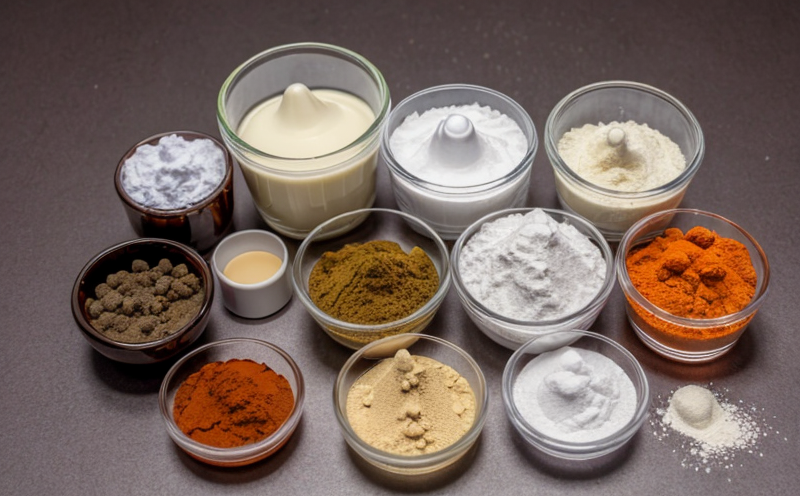GC Alcohol Content Testing
The analysis of alcohol content in excipients and formulation ingredients is crucial to ensure product quality and compliance with regulatory standards. Gas Chromatography (GC) is the preferred technique for this purpose, offering high precision and accuracy. This service ensures that all excipients used in pharmaceutical formulations meet the required specifications.
GC Alcohol Content Testing involves several key steps: sample preparation, injection into the GC instrument, separation of components, detection, and quantification. The process starts with thorough sampling to obtain representative samples from the batch. These samples are then prepared according to specific protocols that may include dilution or derivatization, depending on the nature of the alcohol.
The most common alcohols tested in pharmaceuticals include ethanol, methanol, isopropanol, and others used as excipients like propylene glycol. The choice of standards depends on the intended use of the excipient. For instance, ethanol may be present in certain solvents or preservatives, while methanol might be found in denaturants.
GC instruments typically employ flame ionization detectors (FID) for quantification due to their sensitivity and selectivity towards hydrocarbons and hydrogen-containing compounds like alcohols. The chromatographic column used can vary based on the alcohol’s polarity; polar stationary phases are often chosen for highly polar alcohols.
The method validation process is critical here, ensuring that all analytical parameters meet predefined criteria laid out by regulatory bodies such as FDA, EMA, and WHO. This includes linearity over specified concentration ranges, precision (repeatability and reproducibility), accuracy, specificity, and robustness.
For precise quantification, the instrument must be calibrated using known concentrations of standards before each run. Calibration ensures that the detector responds linearly to changes in alcohol concentration within acceptable limits. Post-run quality checks are also performed by analyzing reference materials or spiked samples to verify precision and accuracy.
| Alcohol | Purpose of Use | GC Instrument Parameters |
|---|---|---|
| Ethanol | Solvent, Preservative | Column: SE30; Detector: FID |
| Methanol | Denaturant | Column: FFAP; Detector: FID |
| Isopropanol | Solvent, Disinfectant | Column: OV-1; Detector: FID |
The testing process is highly regulated to ensure reliability and consistency across different batches of excipients. Regulatory compliance is critical in the pharmaceutical industry due to potential health risks associated with incorrect alcohol content levels.
- Ensures product quality by detecting impurities or inconsistencies that could affect formulation performance.
- Facilitates adherence to regulatory requirements, reducing the risk of non-compliance penalties.
- Supports R&D efforts in optimizing formulations for better efficacy and safety.
Quality and Reliability Assurance
The success of any pharmaceutical product hinges on consistent quality assurance (QA) and reliability. GC Alcohol Content Testing plays a pivotal role in maintaining these standards by providing accurate quantification of alcohols present in excipients. By ensuring that all batches meet specified limits, manufacturers can avoid recalls and regulatory actions.
Quality control begins with rigorous sampling techniques to gather representative samples from the production batch. Once collected, samples undergo extensive preparation steps tailored specifically for each type of alcohol being tested. These may involve dilution or derivatization processes designed to enhance detection sensitivity.
The instrument setup is critical; it involves selecting appropriate columns and detectors based on the alcohol’s chemical properties. Column selection impacts separation efficiency while detector choice affects both sensitivity and selectivity. Regular calibration ensures accurate readings throughout testing, which is essential for maintaining consistent results across multiple runs.
Data interpretation requires skilled analysts who understand not only the technical aspects but also the broader implications of their findings within the context of pharmaceutical development and manufacturing processes. They must be aware of relevant guidelines like ISO 10543:2016, which provide best practices for GC methods in various industries.
Post-run verification includes analyzing reference materials or spiked samples to confirm that the analytical process remains robust under varying conditions. This step ensures that any deviations from expected values are promptly identified and addressed, thus maintaining high standards of reliability throughout production.
Customer Impact and Satisfaction
- Better Product Quality: Ensures consistent alcohol content levels across all batches, leading to improved product quality.
- Regulatory Compliance: Helps clients meet strict regulatory standards, thereby avoiding potential fines or sanctions.
- Enhanced R&D Efforts: Supports innovation by providing reliable data that can be used to refine formulations for better performance and safety.
Customer satisfaction is paramount in the pharmaceutical industry. By offering accurate GC Alcohol Content Testing services, we help our clients achieve these goals effectively. This translates into higher customer satisfaction as they can trust us with their critical testing needs.
The service also benefits customers by reducing waste and costs associated with non-compliant batches or substandard products. Efficient quality control processes ensure that only compliant materials proceed to the next stage of production, minimizing rework and downtime.
Use Cases and Application Examples
- Solvent Quality Assurance: Ensures that solvents used in manufacturing processes contain the correct amount of alcohol, which can affect reaction rates or product stability.
- Preservative Efficacy: Validates that preservatives containing alcohols are effective against microorganisms without compromising shelf life.
- Denaturant Compliance: Confirms that denaturants meet legal requirements regarding alcohol content, ensuring safe handling and usage.
| Use Case | Description | Example |
|---|---|---|
| Solvent Quality Assurance | Determines the purity of solvents used in manufacturing processes. | Ensuring that ethanol-based solvents have no more than 1% water content to prevent degradation during storage. |
| Preservative Efficacy | Evaluates whether preservatives containing alcohols are effective against microorganisms without affecting shelf life. | Testing whether a preservative formulation remains stable over time, even when exposed to higher than normal alcohol concentrations due to manufacturing variability. |
| Denaturant Compliance | Verifies that denaturants meet legal requirements regarding alcohol content, ensuring safe handling and usage. | Checking that a denaturant contains the correct percentage of methanol as required by local regulations. |
In addition to these specific applications, GC Alcohol Content Testing also supports broader goals such as process optimization, continuous improvement initiatives, and ensuring consistent performance across different manufacturing sites globally.





